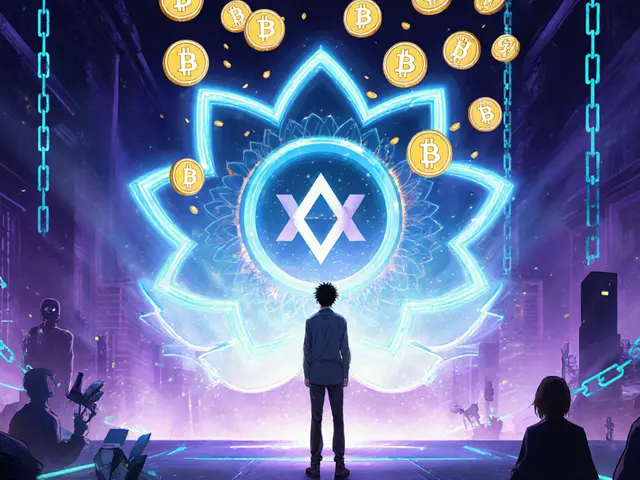DePIN Earnings Calculator
Estimate potential earnings from DePIN projects based on your hardware and network participation. Note: Actual earnings vary based on network demand, token value, and location.
Estimated Daily Earnings
$0.00
Estimated Monthly Earnings
$0.00
Important Notes
Actual earnings depend on network demand, token price volatility, and your location. These estimates are based on historical data from February 2024.
⚠️ Disclaimer: DePIN earnings are not guaranteed. Crypto prices fluctuate significantly. Token values can drop 80% after launch. This calculator is for educational purposes only and should not be used as financial advice.
What Exactly Is a DePIN Project?
DePIN stands for Decentralized Physical Infrastructure Networks. It’s not just another crypto buzzword-it’s a real shift in how physical infrastructure gets built and maintained. Instead of big companies owning cell towers, Wi-Fi networks, or solar grids, everyday people contribute their hardware and get paid in cryptocurrency for it. Think of it like Uber, but for infrastructure. You don’t need to be a tech giant to build the internet-you just need a hotspot, a solar panel, or extra hard drive space.
How Does DePIN Turn Real-World Stuff Into Crypto Rewards?
At its core, DePIN uses blockchain to connect physical assets with digital incentives. Here’s how it works in simple steps:
- You buy or already own a device-like a Helium hotspot, a home battery, or a spare server.
- You connect it to a DePIN network and let it share its resources (bandwidth, energy, storage, computing power).
- The network tracks your contribution using smart contracts-no middleman, no paperwork.
- You earn tokens automatically based on how much you contribute and how useful your resource is to the network.
- You can hold those tokens, trade them, or use them to pay for services on the same network.
This system works because everything is recorded on a public blockchain. If your hotspot provides 100 hours of coverage in a rural area where no cell tower exists, the network knows. And you get paid for it.
The Two Types of DePIN Networks: Physical vs. Digital
Not all DePIN projects are the same. They fall into two clear categories:
Physical Resource Networks (PRNs)
These are tied to real-world locations. Your contribution has to be physically in a place where it’s needed. Examples:
- Helium: People install wireless hotspots to create decentralized cellular networks. Each hotspot covers a small area, and together they form a global network without AT&T or Verizon.
- Power Ledger: Homeowners with solar panels sell excess electricity to neighbors via blockchain. No utility company needed.
- EVgo-style DePIN: Electric vehicle charging stations run by individuals, paid for in crypto.
These networks are location-sensitive. A hotspot in downtown Tokyo is more valuable than one in the middle of the ocean. The blockchain records where each device is and how well it performs.
Digital Resource Networks (DRNs)
These don’t care where you are. You’re sharing digital resources that can be accessed remotely:
- Filecoin: You rent out unused hard drive space. Others pay to store files on your drive.
- Golem: You lend your computer’s processing power for rendering, AI training, or scientific calculations.
- SONM: A decentralized cloud computing platform where anyone can rent or sell computing cycles.
These are fungible-you can move them around digitally. A gigabyte of storage on your laptop in Wellington works the same as one in Tokyo.

Why Do People Actually Participate?
It’s not just about free crypto. People join DePIN because it solves real problems:
- No gatekeepers: You don’t need permission from a corporation to join. Plug in your device and start earning.
- Turn waste into income: That old router collecting dust? Turn it into a hotspot. Your solar panels generate extra power at noon? Sell it.
- Build what’s missing: In places where telecoms won’t go-rural towns, developing countries-DePIN fills the gap. A single hotspot can give a village internet access.
- Transparency: Every transaction, every byte of bandwidth, every kilowatt-hour is on the blockchain. No hidden fees. No black boxes.
Take Helium, for example. Since 2019, over 2 million hotspots have been deployed globally by individuals-not corporations. That’s more coverage than some national telecoms have in certain regions.
How Smart Contracts Keep Everything Fair
Without human managers, how do you make sure people aren’t cheating? That’s where smart contracts come in.
Smart contracts are self-executing code on the blockchain. They automatically:
- Verify that your hotspot is active and in the right location
- Measure how much data you’ve transmitted
- Calculate your reward based on network demand
- Send tokens to your wallet-no delays, no paperwork
For example, if someone tries to fake their hotspot’s location using GPS spoofing, the network detects it. Multiple nearby hotspots cross-check signals. If the data doesn’t add up, you get zero reward. It’s automated trust.
Who’s Winning With DePIN Right Now?
DePIN isn’t theoretical-it’s growing fast. Here are three real examples making an impact:
1. Helium (HNT)
Helium created the first major DePIN network for wireless coverage. Users buy a $200 hotspot, plug it in, and earn HNT tokens for providing LoRaWAN coverage. As of 2025, Helium’s network covers over 80% of the U.S. and more than 60 countries. It’s cheaper, faster to deploy, and community-owned.
2. Filecoin (FIL)
Filecoin lets anyone rent out unused hard drive space. It’s like Dropbox, but decentralized. Over 10 exabytes of storage have been contributed by individuals and small businesses. No Amazon Web Services required.
3. Power Ledger (POWR)
In Australia and Thailand, homeowners with solar panels sell excess energy to neighbors using Power Ledger’s blockchain platform. The system tracks energy flow in real time and settles payments in POWR tokens. It’s cut energy bills by up to 30% for participants.

What’s the Catch? Challenges and Risks
DePIN sounds perfect, but it’s not without flaws:
- Hardware cost: You need to buy a hotspot, miner, or server upfront. That’s a barrier for some.
- Token volatility: Earning HNT or FIL doesn’t mean you’re rich. Crypto prices swing. Some projects have seen token values drop 80% after launch.
- Regulation: Governments aren’t sure what to do with decentralized energy or telecom networks. In some countries, running your own cell network is legally gray.
- Network saturation: If too many people join a hotspot network in one area, rewards drop. It’s not infinite income.
Smart participants treat DePIN like a side hustle-not a get-rich-quick scheme. They look for networks with real demand, not just hype.
Why DePIN Matters More Than You Think
Traditional infrastructure is broken. Telecoms charge too much. Energy grids are aging. Cloud storage is controlled by three companies. DePIN flips the script: it turns passive assets into active income and lets communities own the tools they rely on.
Imagine a future where:
- Your neighborhood’s Wi-Fi is built by locals, not a corporation.
- Your solar panels power your street, not the grid.
- Your old laptop helps train AI models-and you get paid for it.
That’s not sci-fi. It’s happening now. DePIN isn’t replacing the old system overnight. But it’s giving people a real alternative. And that’s powerful.
How to Get Started With DePIN
If you’re curious, here’s how to dip your toes in:
- Choose a network: Pick one that matches what you have. Hotspot? Try Helium. Extra storage? Try Filecoin. Spare GPU? Try Golem.
- Buy the hardware: Most networks sell compatible devices. Prices range from $100 to $500.
- Set it up: Plug it in, connect to Wi-Fi, and follow the app instructions. Takes 10 minutes.
- Wait and earn: Rewards start flowing after your device is verified on the network-usually within 24-72 hours.
- Reinvest or cash out: Some people buy more hardware. Others trade tokens for stablecoins or fiat.
Start small. Don’t go all-in. Test one device. See how it works. Then decide if you want to scale.






